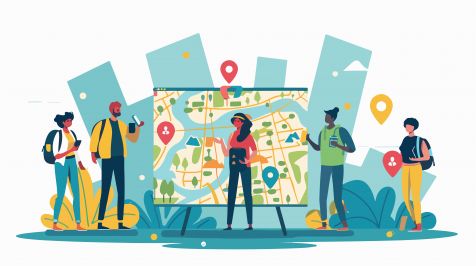
Did you know that even though the way B2B marketers implement certain rules has changed, the rules themselves were roughly clear to our marketing forefathers too?
For instance, the example below showcases an ad published in a trade catalog in 1920, with an aim to capture the attention of the relevant audience.

Source: https://bit.ly/2AG8lFe
This is what targeted B2B ads looked like decades back but of course, targeted ads have come to acquire a different meaning altogether in the digital era where it’s possible to implement targeted marketing using cookies, marketing automation, SEO, and paid ads.
In general, in today’s era, offline marketing tactics like sponsorship, word of mouth, trade shows, business cards, leaflets, and pamphlets are, if not replaced, supported greatly by digital marketing.
Shift to Digital Platforms with the Advent of the Internet
Digital transformation is more than just a buzzword today. A lot of industries are reinventing themselves using technology that will leave you stunned. In fact, 27% of senior executives consider digital transformation as a matter of survival. The consumer buying process was uncomplicated and clear-cut in the past. Advertising was the only aspect that companies needed in order to control the demand of products. Traditional marketing methods such as Newspapers, Magazines, Television, and Radio were used to promote the products to the customers.
With the introduction of technology, as more people are using the internet, the traditional strategies have started to fade out. The gradual shift to the cloud has drastically changed how companies approach B2B marketing. Customers now use different platforms such as Google, YouTube, and Facebook to make their purchase decisions. The new marketing techniques enable a two-way conversation rather than a one-directional conversation used in the past.
B2B Marketing Techniques that Help Business go Digital
Considering the increasing impact of B2B marketing, it is essential to decide which strategies will help reach a specific business audience. So, here are some effective B2B Marketing strategies that can make an impact.
B2B Email Marketing
A tried and tested method of reaching out to business consumers is B2B email marketing. Approximately, 93% of the B2B marketers use email marketing to get in touch with their customers. Engaging emails can turn subscribers into leads and gradually into customers. Email marketing is a powerful tool that can highlight a brand. The email marketing campaigns need to meet the expectation of business customers and focus on factors such as time, money, and resources. In fact, B2B customers pay more attention to logic and positive ROI. B2B customers are more concerned about logic and positive ROI as compared to emotions and entertainment. However, with almost all the companies switching to B2B email marketing, it is necessary to create effective marketing emails that improve your conversion rate. Moo.com, for instance, uses simple GIFs in their marketing emails to remove the monotony and gain the attention of customers for all the right reasons.
Up the Content Marketing Game
In an age where content is the king, it is necessary to develop a content strategy, based on the needs of the customers. However, millennials, who form one-third of the B2B buyers, believe that marketers don’t meet their expectations when it comes to marketing content. To be more precise, millennials account for 33% of the B2B customers and in the next 5 years, the numbers are going to increase. Not catering to the millennials implies that you are wasting millions as you are not producing the kind of marketing content that millennials prefer.
Marketers tend to ignore the fact that millennials play a major role in B2B purchasing. This is where customer-related content helps greatly in the digital age. Buyers gather all the necessary information about the product on their own before making the final decision. Approximately 67% of buyers prefer to research online to compare their options and make decisions. To meet the needs of the modern-day buyer, businesses need to go for a digital transformation. By 2020, it has been estimated that customers will manage approximately 85% of their transactions with brands without interacting with them in person, according to Gartner.
Keep an Eye on CRO
For B2B marketers, Conversion Rate Optimization (CRO) is not a new term. However, a lot of marketers are so obsessed with driving traffic that they pay less or no attention to optimizing their site. In fact, for every $92 that you spend on acquiring leads, only $1 is spent on CRO. For B2B, conversion optimization is quite different. Along with increasing website traffic, businesses need to nurture the leads to sales. A conversion-optimized B2B website can help in understanding the needs of the customers and attract the right prospects. When businesses take the right steps to increase CRO, they can reach the right prospect even before a customer sends an email or calls.
B2B Social Media Marketing
Approximately 75% of the B2B buyers take the help of social media to make purchases. Social media marketing isn’t just for brands that target individual customers but is equally important for B2B companies. Social media is a powerful tool to develop brand awareness, give a reputable personality online, and give businesses a human touch. These are very powerful factors when it comes to marketing or connecting with potential customers.
The Present Scenario
With most of the sales channels changing to B2B industries, businesses are aware of the fact that if they don’t embrace digital transformation, they could be out of business. Today, B2B customers expect a broader selection of products, faster delivery, and relevant product information. Customers expect to buy products and services from multiple channels such as marketplaces like Amazon, e-commerce, and digitally-enabled sales teams. B2B businesses can take advantage of this scenario and drive competitive advantage by:
- Using Ecommerce to sell directly to customers
- Taking advantage of marketplaces
- Getting digital assistance from the sales team
Take the example of Intel, an American tech giant, which started using an integrated data program. The initiative brought together different departments such as supply chain, marketing, sales, and finance departments in an easy and innovative way. The supply chain operations of Intel are processed as well as optimized as a result of AI transformations, which helped them save $58 million.
The Bottom Line
Digital transformation is a way to reinvent your company so that you stay relevant and competitive. A lot of companies such as Intel, which have been saved by digital transition, know the importance of creating products that are not only time-saving but also easy to use and provide a better return on investment (ROI). Shifting to a digital platform is challenging, but the risk is worth your efforts if you plan to become an industry leader.





